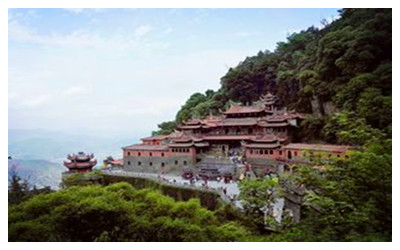Skype: neodalle-travel
Tel: +86 135 7447 2266
E-mail: sales@visitaroundchina.com
 Water Rock Temple is a Buddhist temple built high on Penglai Mountain in Anxi County. The architecture is a three-layer tower style built with blue bricks and red tiles. Hiding in the emerald bamboos, green pines, hazy mist, and clouds the temple looks grand and imposing. Around the temple, there are many unusual natural wonders as well as cultural relics, such as the ancient tree with all its branches growing northwards, the four stone bamboo shoots towering to the sky, and the precious Ming Dynasty (1368-1644) stone tablets showing the map of the mountain.
Water Rock Temple is a Buddhist temple built high on Penglai Mountain in Anxi County. The architecture is a three-layer tower style built with blue bricks and red tiles. Hiding in the emerald bamboos, green pines, hazy mist, and clouds the temple looks grand and imposing. Around the temple, there are many unusual natural wonders as well as cultural relics, such as the ancient tree with all its branches growing northwards, the four stone bamboo shoots towering to the sky, and the precious Ming Dynasty (1368-1644) stone tablets showing the map of the mountain.Covering an area of over four square miles, Quanzhou Water Rock Temple (Qingshui Yan Temple) is located in northwestern Anxi County. Situated at the foot of Penglai Mountain, it is a fantastic tourist resort for both admiring scenic spots and appreciating the Buddhist culture.
Built in 1083 in the Northern Song Dynasty (960-1127), Water Rock Temple was originally called Zhang Yan. Later, a Buddhist monk, Chen Puzu, who cultivated himself here, changed its name and founded this temple. When Chen passed away in 1101, local people carved his figure with eaglewood to show their respect. Because of the migration of the local people, over 300 branches of Water Rock Temple now can be seen in Taiwan Island, Japan and other areas in Southeast Asia.
Facing a yawning ravine, the temple was constructed based on the topographical feature of Penglai Mountain. The three-storied pavilion-style temple forms a Chinese character, 'di' (the emperor), looking rather lofty against the mountainous landscape. The first floor is Haotian Kou, and the second Zushi (founder of the temple) Hall. The third floor is Shijia Lou (hall of Sakyamuni), along with Tanyue Hall, Kwan-yin Hall and Fangming (good reputation) Hall lying in its two sides. The wall of the temple was built with red bricks and blue tiles, which appears quite pleasing under the set of lush pine trees and emerald-green bamboos.
Additionally, historical and cultural relics are abundant in Qingshui Yan Temple. Among the existing ones, 29 sites were built in the Song Dynasty (960-1279), one in the Yuan Dynasty (1271-1368), eight in the Ming Dynasty (1368-1644), five in the Qing Dynasty (1644-1911), and 23 have been exploited in modern times.
To illustrate some of them, there is an ancient camphor tree with all its branches pointing to the north. Legend says that in this way the tree shows its discontent about Song court's unfair treatment towards Yue Fei (a loyal general in Song Dynasty). Erected in the Ming Dynasty, the 'Yan Tu Beike' (a carved map of Water Rock Temple on a stone tablet) is considered as an unwonted guide map in ancient times. Also, there is an interesting Luohan (Buddhist arhat) pine which grows four inches per year but becomes shorter once confronted with the lightening and the thunder.
Upon climbing the mountain, visitors will find the Banling Pavilion and Hujie Palace, as well as many stone carvings in various shapes. Behind the temple, there are four splendid stalagmites standing straight on the mountaintop as if they are being thrust into the sky.
Quanzhou Water Rock Temple has been nominated as a Grade AAAA National Tourism Zone in 2002. The best time to travel here is from April to November.
Travel Tips
Add: in northwestern Anxi County. Quanzhou City,Fujian Province
Admission Fee: CNY 15
Opening Hours: 06:00 - 17:30
 Ask Questions ?
Ask Questions ?